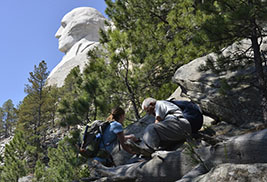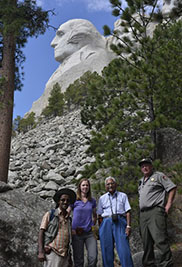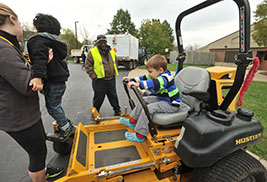Featured Article
Kent State’s Child Development Center and University Facilities Management Host “Meet a Truck”
The children of Kent State's Child Development Center were introduced to the maintenance trucks on campus by the University Facilities Management team.
read moreCan Fireworks Damage Mount Rushmore?
Posted Oct. 20, 2014 | Jim MaxwellKent State researchers study the stability of national monument

Kent State University graduate student Lindsay Poluga
and Professor of Geology Abdul Shakoor use the
Brunton compass to take discontinuity measurements at
Mount Rushmore.
(Photo credit: Eric Bilderback)
For Kent State University Professor of Geology Abdul Shakoor, Ph.D., studying the stability of Mount Rushmore, visited by nearly three million people each year, was a lifelong dream.
So, in 2013, with the help of his graduate student Lindsay Poluga, the two of them reached out to the National Park Service to develop a research project and write a grant proposal. The $25,000 National Park Service grant was awarded this past summer and Shakoor and Poluga traveled to Mount Rushmore, in the Black Hills of South Dakota, to study the effect of vibrations on the sculptures associated with the annual Fourth of July fireworks exhibit.
The National Park Service has not had fireworks set off for the Fourth of July celebrations since 2009 due to the fire hazard caused by the mountain pine beetle infestation.
“They (National Park Service) are interested in finding out if future firework activity will cause any damage over a long period of time,” Shakoor says. “Mount Rushmore is one of the most dramatic and widely recognized features in the world, and the structural integrity of its famous presidential sculptures is of utmost importance.”

Pictured from left to right are Yonathan
Admassu, assistant professor at James
Madison University and Kent State alumnus;
Lindsay Poluga, geology master’s student;
Abdul Shakoor, Kent State professor of
geology and principal investigator; and Bruce
Weisman, integrated resource program
manager for the National Park Service.
(Photo credit: Eric Bilderback)
Shakoor and Poluga mapped and characterized fractures in and around Mount Rushmore and collected granite, pegmatite and schist rock samples that they are currently testing in the Engineering Geology lab in McGilvrey Hall on the Kent Campus.
“Although the air blast frequency and vibrations produced by the annual fireworks may be low, it is possible that accumulated movements along natural fractures in the sculpture may result from cyclic effects,” Shakoor says. “It is also possible that if multiple fireworks blasts simultaneously went off in the air, the resultant air blast may produce vibrations sufficient to cause movement on the fractures present in and around the monument.”
The researchers will process light detection and ranging (LiDAR) data to study the orientation of the fractures on the sculptures themselves and their influence on the overall stability of the monument. Data from the rock block monitoring system, installed by the National Park Service in 1998, will also be analyzed to determine if there are movements along the fractures during any previous Fourth of July fireworks celebrations. They also will be looking at temperature fluctuations and its effects.
“If I can obtain access to the data from the National Park Service, I would like to see if I can observe any change in the pattern of the shifting along the discontinuities during the days when fireworks were set off compared to the days when fireworks were not set off,” Poluga says.
For more information about the Department of Geology in Kent State’s College of Arts and Sciences, visit http://www2.kent.edu/geology/index.cfm.
For more information about the Mount Rushmore National Monument, visit http://www.nps.gov/moru/index.htm.
